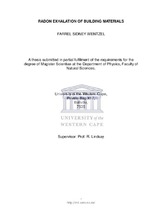| dc.description.abstract | Public concern about all radiation and radon exhalation from building
materials has been highlighted recently. The purpose of this study is
to address this public concern and to investigate the contribution of
building materials to indoor radon levels. As in soil and rocks, radon
gas is formed inside the building materials by decay of the parent
nuclide 226Ra. It is not possible to determine the radon exhalation rate
simply from the activity concentration of 226Ra, instead one must
measure radon exhalation rates directly from the surface of the
material. 222Rn has been identified as an important factor that could
result in a health hazard by studies all around the world.
The exhalation experiments were done at the UWC physics
department, in the Nuclear Physics Lab. A RAD7 radon detector was
used to measure the radon concentration in an air tight chamber that
contained various building material samples. The RAD7 records the
number of alpha particles with energy of 6.11 MeV which results from
the decay of 218Po, the daughter of 222Rn. The RAD7 detector converts
counts into Becquerel’s per cubic metre (Bq/m3). The building
materials tested were the raw materials used in construction such as
two different types of building sand, building stones, coarse
aggregate, floor and roof tiles, various granites from across the world
that were sourced locally and uranium bearing sandstone originating
from a Beaufort-West prospecting site. Stones from this site were
used as filler material in the construction of two farm houses. Most
building materials were found to have a very low rate of radon
exhalation. The only materials that had any significant radon
exhalation were 2 granite samples with a maximum exhalation rate of
1.5 Bq.m-2.h-1 and the uranium bearing sandstone. It is safe to say that
the overwhelming majority of building materials tested are safe to use
but some granites may require further study. The uranium bearing
sandstone is a definite radiation protection issue and should not be
used in any construction. | en_US |

